This number of the JOURNAL is devoted to the subject of American Art, the native production untouched by outside influences.
The sense in which I use the term includes not only painting and sculpture and all the decorative arts but the art of story telling as well, which implies the literary gift. It is obvious that the pages of the JOURNAL do not afford scope for an extended critical treatment of Indian Art with its varied parallel lines of development and their cross currents. Our purpose goes no farther than to illustrate some local phases of Sculpture, Painting, Applied Design and Story Telling. This reduces our task to the consideration of a few chosen examples from a rich and varied background.
There is surely no country in the world in which artistic expression moves through a wider compass or embraces a broader range of subjects or has recourse to a greater multiplicity of method and expedient. The aboriginal Americans were of an artistic temperament. That temperament is seen in its simpler forms of expression among the surviving peoples who, never having attained great economic development, preserve early artistic traditions corresponding to their several positions in the scale of culture. Among the ancient peoples with advanced civilization in Mexico, Central America and Peru, the native artistic tradition blossomed independently under local influences. In each of these favoured spots it put forth fruit abundantly, acquired a vigorous growth and attained to high levels. In none of these places has this flourishing condition of the arts survived into our own day. The ancient art of Central America and Peru and Mexico is extinct as the art of Egypt is extinct, but as the one may kindle new thoughts in our own generation, so the others may likewise give a new impulse to our creative faculties.
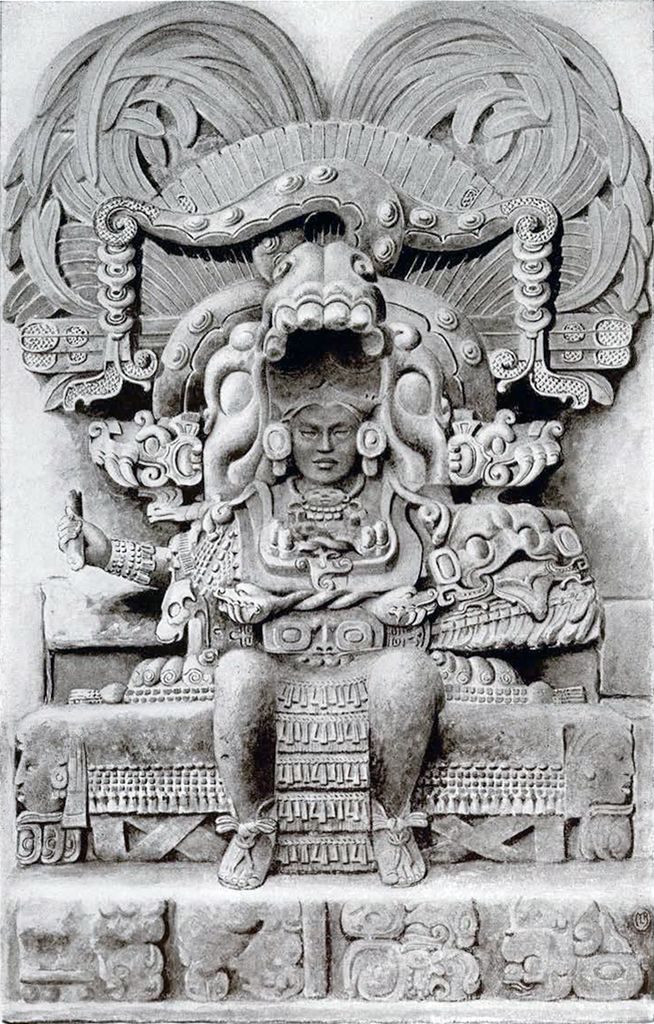
Image Number: 19654
A candid view of artistic expression from the historical side calls for a recognition of ancient American Art as a part of the world’s inheritance. It stands entirely on its own merits and holds its own in spite of its isolation.
Although comparison brings out many interesting parallels and equally interesting divergencies, it is not necessary to talk about American art in terms of equality with the art of other continents. To do so would be to strain the uses of language, but it may be admitted at once that ancient American art has its own lessons and in some at least of its local developments was not lacking in elements of greatness. In one department this is best exemplified by some of the sculptures of Central America. For this reason I have selected a few examples from among the many scarcely known sculptures found in the ruined cities on the Motagua and Usumacinta rivers, one object of exceptional character found on the banks of Uloa River and another of unknown provenience.
Painting, sculpture and the decorative arts generally, though more developed in some quarters than in others, were widely cultivated by the inhabitants of North and South America. There was also a common property in folk-lore, in myth and in heroic tradition interwoven with magic. These narratives changed according to place and to tribal prerogative, but any one familiar with them can hardly fail to recognize a certain pattern common to them all. There is at least a thread or two of the same color that runs through all these mythical and legendary weaves. This does not deny to native American myth making and story telling either richness or variety. Both qualities were present in varying degree. In some places more than others, the warp and woof of native myth and story were woven with accomplishment. In such places the pattern of each piece presented symmetry and refinement and took on the form and colour of a productive local genius responding actively to a favorable environment. Such was the condition in Central America where the civilized Mayas counted the art of writing among their achievements. It is true that we know little about the mythology of the Mayas and less of the style of their narrative, much less indeed than we know about the similiar possessions of uncivilized tribes. I do not think it possible to restore that lost possession. Whatever it contained of literary art is lost to the world. I believe, however, that a faint notion of some of its traits if not of its content may be derived from the folk-lore that is told in remote corners of Central America today. For this reason and also on account of their general character as purely native American myths, I give several exam-pies of a single type of story. They will serve to illustrate the fact that America possesses a background of native tradition that has its own resources and that is capable of supplying fresh motives in artistic and literary production. The same purpose will be no less faithfully served by another type of narrative with an historical setting, from an entirely different source: The Legends of Kit-selás.
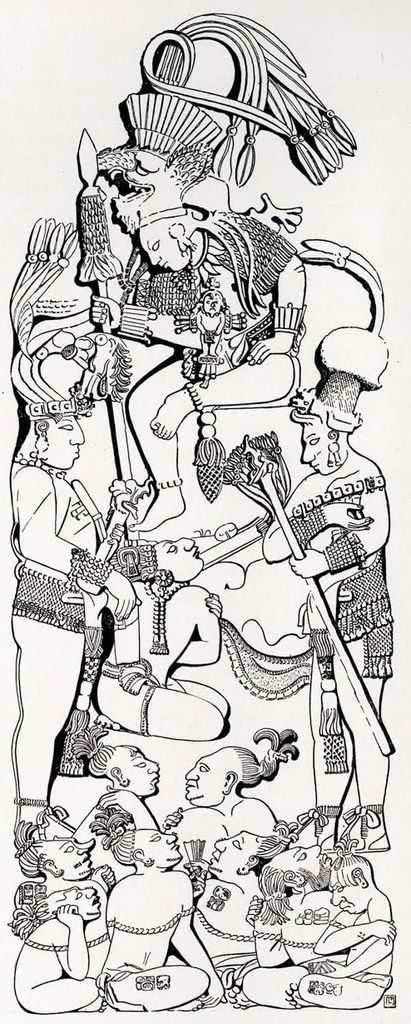
So far as Central America is concerned there is a violent break between the sculptor and his art on one hand and the art of story telling on the other. There is little hope of repairing that break, but it is a reasonable assumption that there existed between those two a close correspondence. All the art in the world, even that of greatest promise, derived its first inspiration from legend and found its fulfilment in the interpretation of myth. That such was the case in Central America there is good reason to believe. We may hardly doubt that in many instances the subjects chosen by the artists were the heroes of old tales.
Unlike the storied sculptures that elsewhere in the world have come down from antiquity, these Central American sculptures have no clear surviving tradition travelling down the centuries with them or running on before. They have survived the hero tales of their lost Iliad. Their interpretation depends not on legend, not on the fancies of contemporary writers and not on any side light that history affords, but on the force of their own unaided message and on the eloquence of their own appeal. It depends on the language of the sculptor and it depends on our own understanding of and sympathy with that language. Our pleasure will therefore be in proportion to the success of the unknown artist in making his work speak across the centuries and out of the silence. We do not know what became of these artists or of the things to which they bore witness, but we believe that they honestly tried to paint these things as they saw them. They went down, I presume, before some superior force. It may have been the Aztec or it may have been the Fever. The point to be remembered is that we are dealing with an episode in the history of art of which we know nothing, an episode that lacks the synchronizing intervention of literature. It comes to us without introduction; it has no contemporary legend to commend it, nothing but the qualities with which its creators endowed it.
A King in All His Glory
Some years ago it was my fortune to excavate a great stairway buried deep beneath the debris fallen from the ruined buildings that the builders had reared on the height above. That stairway had once been the grandest sight in the ancient city of Copan in Honduras.*1 With its elaborate balustrades, its total width was thirty feet and its steps had numbered nearly a hundred. Every stone in that great stairway was carved and wrought in harmony with a consistent design in which the conception of the architect unfolded itself in one daring and monumental plan. The masonry was carved after the stones had been placed in position.
I am not going to describe the stairway, but I am going to make use of one of its details to illustrate some of the properties and attributes of Central American sculpture. That detail is the figure of a man, life-size or a little more, built into the stairway as a part of its central structure in such a way that the figure appears seated on a step high above a huge and elaborately sculptured altar or dial that was built into the base, projecting in front of it and rising from the pavement below.
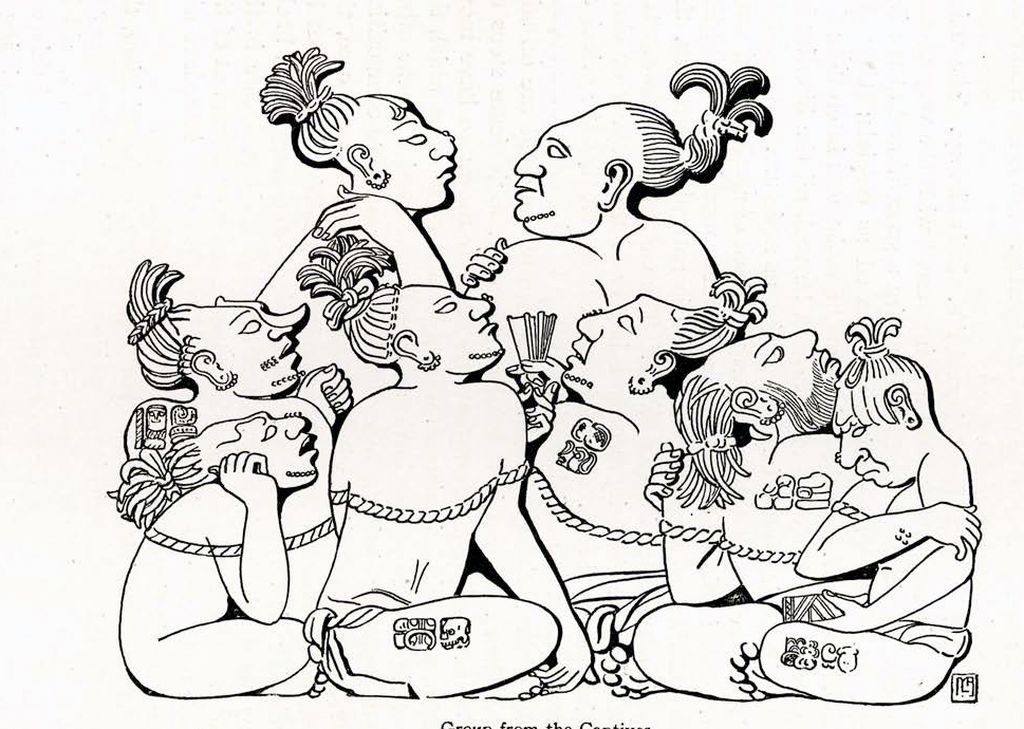
There had been a number of these seated figures, one above another all the way to the top, but only one remained in position. It was composed of several blocks of stone that had been carved after having been put in position. The sculpture was in very bold relief, but the right arm with its hand was carved in the round and stood free. The figure when found had suffered some injuries. The object held in the right hand was broken away. The face was destroyed and the upper part of the headdress had fallen. This part, however, was recovered during the excavations and could easily be replaced; only the upper curve of the plumage was wanting. In the drawing that I give here these plumes are restored. They are restored in a way that is justified by the facts and that satisfies all requirements. The curved lines of the feathers are indicated quite clearly in the part that remains and they are simply produced in the necessary way. Moreover, the drawing has been checked and verified by careful study and by comparison with the plumage on numerous other figures. The only other restoration in the drawing consists of the features of the face, which were obliterated and left blank by the scaling of the stone and by weathering. The features in the drawing are therefore restored features, constructed from a careful study of other faces found at Copan. All the other details of the sculpture remain as shown in the drawing, which is prepared from a photograph.
I do not know how to describe this figure. Perhaps it is not necessary. I take it that the person shown was a man of impor-tance—of very great importance. I take it that the artist meant to convey that impression. There is here certainly a dignity and repose that suggests the person of a king. The result was not achieved, however, by resorting to simplicity or by relying on the possibilities of the human figure alone and unaided. The artist had another method and he justified that method by his result. He added all the attributes that belonged to his subject’s rank and dignity down to the minutest detail. In this he scored a triumph, for he succeeded in putting on all the trappings pertaining to the sovereign rank of his subject without making his figure either fantastic or absurd, but in such a way that every added detail does honour to his craft, emphasizes the nobility of his labours and gives greater glory to the statue of his Majesty, the King.
In this use of Emblematic Motive and Insignia the artist faced a difficult task which he performed with much skill. There were no soft persuasive folds and no flowing robes to cheer his heart and challenge the dexterity of his fingers. Stiffness was the quality that he had to deal with in the dress and ornament and he dealt with that quality quite frankly and honestly. That he could also handle flowing lines and allow himself the freedom and movement that these natural conditions afford, is proved by his joyful treatment of the plumes in the headdress. But he went farther both in realism and in symbolism than the drawing even with its restoration implies. It does not tell the whole story. It gives but a faint idea of that figure when it was entire. The artist had recourse to an expedient apart from the work of his chisel. He was also a painter and the statue in its original condition was, like the whole of the structure of which it formed a part, a mass of colour, the different parts being picked out with the brush in tones that were appropriate to them.
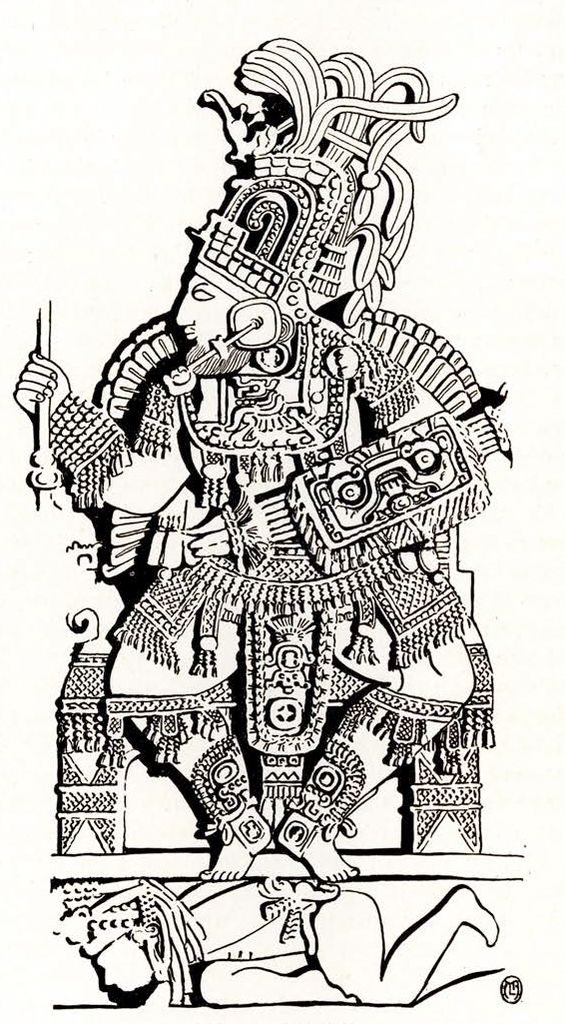
There is a word that writers on the subject of Greek art in particular are used to employ in their descriptions of the methods of the Greek artist. The word is “restraint.” It is a good word whether applied to art or to any other part of life. It represents a fine quality that has been observed in Greek art especially and that appears to be closely associated with its greatness. There are occasions, however, in the lives of men when both pleasure and propriety call for the exercise of other qualities than restraint.
I do not know whether the sculptor that made this statue of a king had restraint or not. Perhaps he had, but I will not try to prove it. He probably knew what it meant but did not think it necessary to overwork the device.
In judging the figure as a work of art it is necessary to remember that we are looking at it apart from its surroundings and detached from the structure of which it was a component. It was not intended to be seen in this separate way. It was carved in position. It was a note for emphasis and a centre of interest in an orderly composition. It was meant to be seen in relation to the ascending stairway that occupied a steep slope one hundred and fifty feet in height. It is not possible to reconstruct that elaborate work in the mind’s eye, but we can recognize the fact that the circumstances that deprive us of that advantage also deprive this statue of its original and purposeful effect.
There are only two or three details of the sculpture that I will try to describe. It will be seen that the head is protected by the gaping jaws of a monster or dragon in such a way that the features of the man appear to look out from the creature’s mouth. The upper jaw, with its row of teeth, projecting snout and curved nostrils, is carried well forward above the brow; the lower jaw, also armed with tusks, protects the chest. Above and about these monstrous jaws is disposed the most extraordinary feature of the entire figure. It consists of a pair of rattlesnakes with their bodies interlocked. The heads of these two serpents look out horizontally on either side of the dragon’s head and take the place of its ears. The well modelled serpent bodies are turned sharply upward and curve round the contour of the dragon’s head. They are carried over the top till they meet above the crown. At this point they cross each other and are then bent back symmetrically till they cross each other again in reverse and are then carried horizontally to right and left with a graceful curve. Each tail ends in a curl from which the rattle hangs perpendicularly on either side of the dragon’s head. To the rattle is attached in each instance a double scroll. Behind the coils of these two rattlesnakes rise the waving plumes in which the elaborate headgear culminates. All these devices are clearly appropriate to the idea embodied in the statue and each part is exactly in its place. The broken emblem held in the right hand, the shield on the left shoulder, the belt, the dragon’s head and all the other items are evidently disposed with the most scrupulous regard for propriety and the correctness of things. Nothing is slurred over and no detail is omitted. Caesar got what belonged to Caesar as he should. If the artist was not a great artist he at least knew his duty. We can safely give him credit for that.
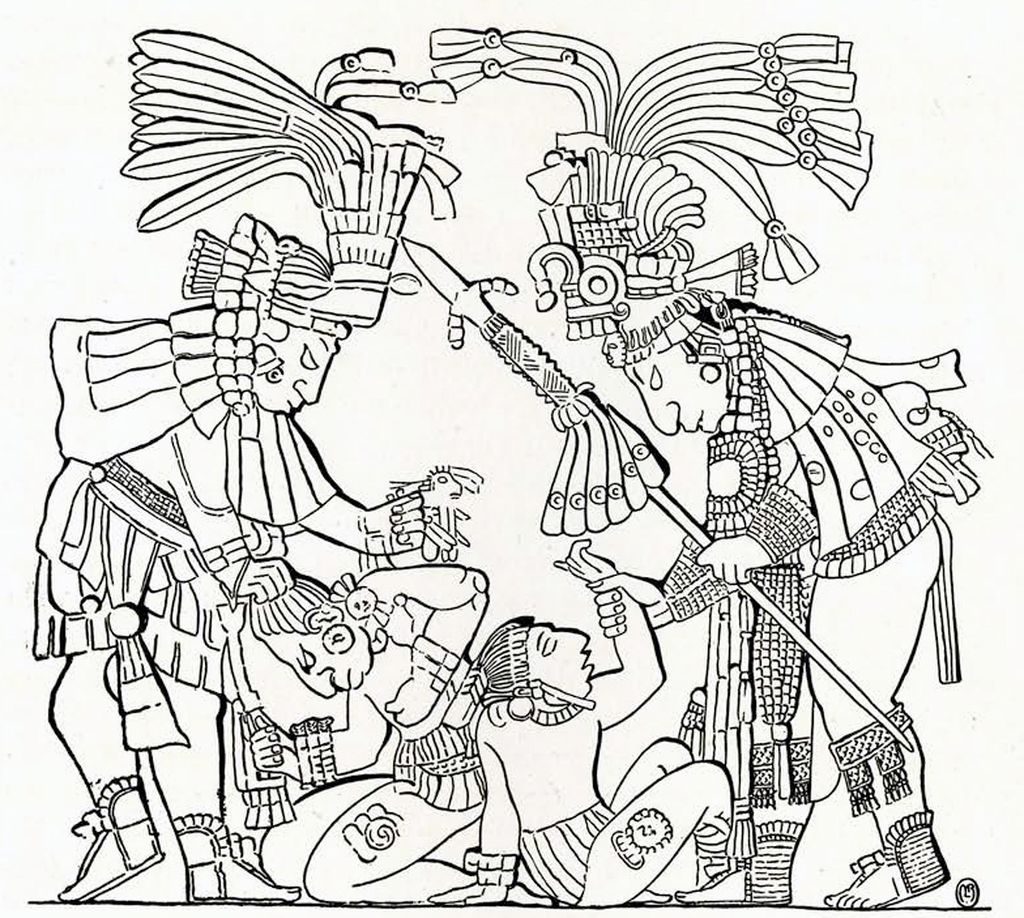
These are some of the thoughts that come to one who looks at this piece of ancient sculpture. The artist, though adhering to convention and faithful to tradition, carved his lines with freedom and gave rein to his imagination. It is no conventional figure that we see, but a real person, in whose sculptured form there is both strength and refinement. The artist who created this figure had a difficult task. He had to build up his figure as a harmonious part of a vast architectural composition; he had at the same time to make it a centre of interest and a strong note in that composition; he had also to build up the historical emblems and sacred attributes that clustered round the immediate person of the king, emblems that represented personal prerogatives handed down by his ancestors; he had to remember also the majesty of the king and he had to make a portrait from the life; he had to satisfy the architects, the priesthood, the heralds, the historians, the courtiers, the members of the royal family and his own conscience. Considering the task, I think he was very successful. I do not doubt that he scored a great triumph in his day. I like to think that he did.
The king still sits on the mounting steps that once led to the temple on the height above. All around him is ruin. The emblems of his majesty are mutilated; his person is defaced; his eyes are gone; he does not see the barrenness and the squalor that have replaced the courtly manners, fruitful life and intellectual freedom that flourished in his own happier, more benevolent, colourful and cultivated age.
How do I justify this comparison? The evidence is written large on all the disjointed fragments over which that gray figure of a king presides; fragments that strew the forest for miles around and that adorn the piggeries in modern villages far away.
The Captives
The next example that I am going to present to the readers of the JOURNAL to illustrate Central American sculpture was found a few years ago on the Usumacinta River. It was found by Mr. T. Maler and photographed by him for the Peabody Museum of Harvard University. The drawing that I give is made from the copy of that photograph published in the Memoirs of the Peabody Museum.*2 The object is a stela three meters high. It had stood in a public place in an important city of which absolutely nothing is known historically. When found it was broken in several pieces, all of which fitted together quite perfectly. The sculpture is in low relief and well preserved. The plain spaces on the background of the picture are filled in with rows of hieroglyphs which cannot be read and which are omitted in the drawing.
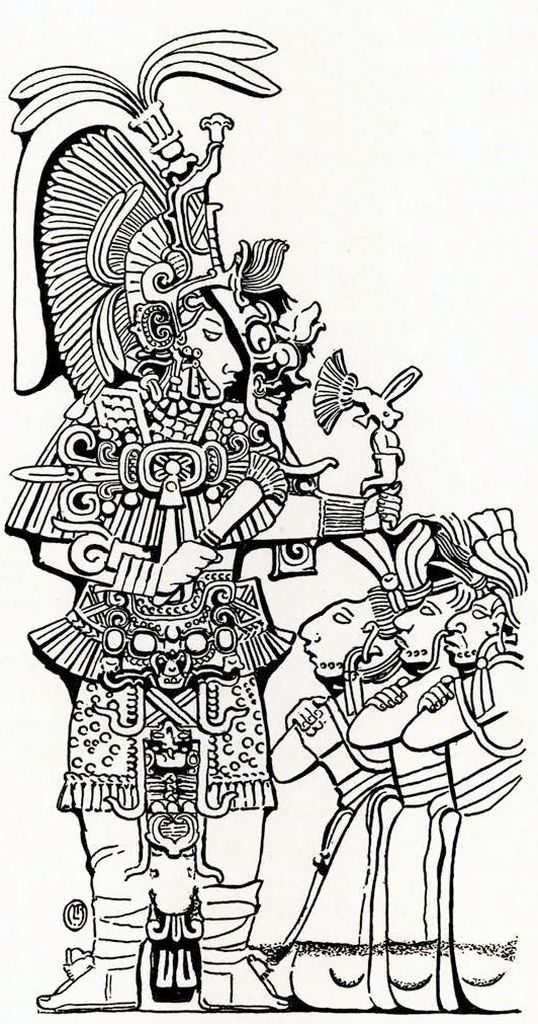
If we could read the inscription we would probably have direct information through these literary channels, but even as it is, the story seems plain enough. The artist has made it plain. There are twelve figures in the composition. The dominating figure is that of the prince who sits high on a throne and looks down on the scene below. His left hand rests on his left knee, which is drawn up beside him. His right hand grasps a spear. His feet are bare, but he wears a feather cape and a large headdress with waving plumes. He also wears a collar and, suspended from it, he wears a little image probably carved from jade. His position is easy and natural. The attitude is not wanting in grace and dignity. In front of the throne stand two officials, one on either hand, stiff, formal and full of importance. Between them, crouching, is a captive. He is looking up boldly at the prince in whose hands lies his fate and who leans forward regarding him attentively. The prisoner is a man of some importance. He is treated with consideration. He is not bound. He has a necklace, a crown and other ornaments, although he is mostly naked. Below these figures and in the immediate foreground of the picture are eight other prisoners of a different class. They are not treated with consideration. They are bound together with ropes. They have their names or the names of their clans or their countries stamped on their persons. One is heavily bearded and one is fat and some show tatoo marks on their faces. All but one are young men and all but one are looking up eagerly and expectantly, hopefully watching the proceedings. The one exception claims special attention. Look at the old man in the lower right hand corner, thinking hard and scratching his bare left arm with his right hand. This veteran has no illusions. He has played and lost and he knows all about it. He is not interested in the immediate proceedings.
There is no doubt that it is real life. It is history. The artist witnessed this very scene. He was impressed with the very proper person of the prince and he has given him a graceful and attractive appearance. The two officials are treated as officials; they are formal and correct. In the prisoners the artist was interested; he made a study of each one of them and he took all the liberties he needed with their persons in order to give us a picture.
There are just two things about this work of art that need comment. One is the relations of space in the composition. That the prince should be elevated on a throne is natural. Moreover, the throne is represented in some detail. The curved lines between the two officials are the fringes on the border of the drapery or cloth covering the royal seat. It will be seen, however, that the principal prinsoner, the two officials and the group of eight prisoners appear to be on three different levels. Also two of the eight are on still another level. There is not a line, however, to indicate steps or platforms. I do not know that the sculptor meant to have more than two levels in this picture. The top of the throne on which the prince sits is one of these levels and the floor on which all the other persons stand or sit is the other level. The rest of the composition has reference to considerations of space. This being the case, the artist did not get what we call perspective into his picture, but he was feeling his way toward it. He has indicated foreground, background and middle distances. The height of this sculpture is the result not of the added heights of several grades or levels but of the artist’s endeavour to give the effect of space and to introduce distance into his picture.

The other thing about this sculpture that calls for criticism, the really odd thing about it, is one which at first sight would appear to be a series of artist’s blunders. I believe that this view would be wrong, though I can offer no satisfactory explanation of this odd thing. Look at the right hand of the principal captive sitting at the foot of the throne. His right hand is carried around his back to his left side and in this curious manner he is nervously grasping his left arm with his right hand. This is all right so far, but the odd thing is that the hand is reversed. Four fingers show, the thumb being concealed, and the forefinger is where the little finger ought to be, and vice versa.
Now look at the captive with the whiskers in the group below. His arms are crossed behind his back; possibly they are tied in that position. His left hand grasps his right shoulder in an action identical with the one just described, except that this time it is the left hand that is shown. All five fingers are seen and they are in reversed position; the thumb is where the little finger belongs and the little finger takes the place of the thumb. Look again at a third figure; the second from the left in the front row of captives. His right hand is also feeling for his left shoulder behind his back. All four fingers are clearly seen and their position again does violence to nature in the same way as before. Yet again, this same man’s left hand, which hangs limply by his side, exhibits exactly the same unnatural disposition. I do not believe that the artist was capable of doing these things unconsciously. There should be some other explanation which if we knew something about his traditions and his ideas, might be clear to us.
It is said that Japanese architects will sometimes purposely put a column upside down or commit some other equally obvious error to avoid creating a perfect work, a privilege which, they hold, belongs only to the Supreme Architect, who must have no rivals. I do not know whether some similar idea may have influenced the Central American artist or not, but I am persuaded that there is a reason for the error in his work. Even if he had been so ignorant or stupid or careless as to be unaware that he was doing anything peculiar, the critics would not fail to speak of it openly. I stated that when it was found a few years ago, this sculpture was broken in pieces. I forgot to say that this damage was done by time and the general ruin. It was not due to the opinions of the artist’s contemporaries or to anybody’s views on art. Whatever may have been his motive for doing this atrocious thing, the Central American artist got away with it.
A Portrait in Relief
The sculptures found along the Usumacinta River are in bas-relief, sometimes quite flat. The example selected for the next illustration is a stela which has on its face a figure of an important personage, perhaps a local governor. The relief is quite low and the lines are very fine. A bearded man is shown in full regalia seated on a chair or throne which appears as if cushioned and tasseled. The high back of this seat is seen behind the head and shoulders of the man who occupies it. The chair is shown in perspective quite correctly and the legs of the man from the hip to the knee are foreshortened. These two things, the drawing of an object such as a seat in perspective and the foreshortening of lines and parts, are worthy of special note. I do not know of any other example of sculpture in relief, or any painting for that matter in ancient America, in which such knowledge of the laws of perspective is so much as suggested. The seat is raised on a dias. On the vertical front of this dias is seen a picture of a captive by way of decoration. The feet of the man occupying the seat rest on the dias.
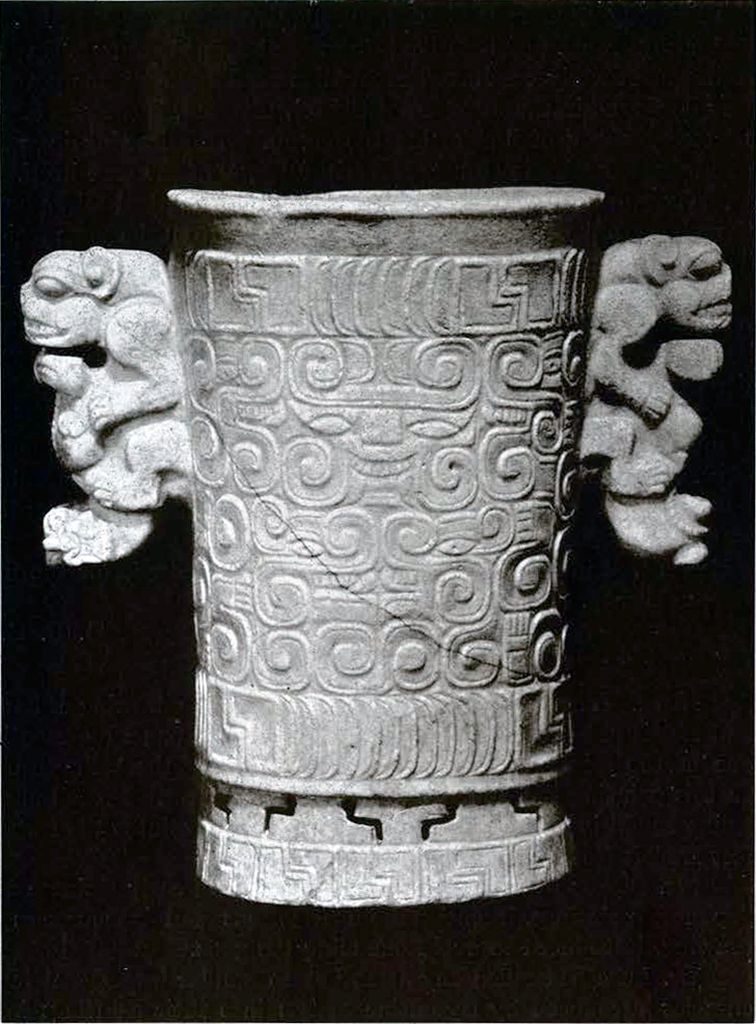
Museum Object Number: NA5526
Image Number: 19506
The feet do not want expression; they are carefully drawn. The toes do not lack definition, yet they are interchanged. The right foot is on the left leg and the left foot is on the right leg. This must have been done with full knowledge and for a reason. I do not know the reason. I cannot say whether the sculptor belonged to a school of artists who professed that good art required the interchanging of feet or who pretended that the true artist had to get away from Nature somehow. What appears to be his error may have been an act of renunciation of a kind not unknown among the world’s peoples. The artist may have said to his patron with becoming modesty.
“If I allow myself entire freedom I shall produce a perfect man like yourself. To do a perfect piece of work would be quite natural to me and to the practice of my art. On the other hand, to do so would be a risky business because, since the gods like to think they alone can attain perfection, their jealousy might do me some harm. Besides, they might also send down misfortune on you and on your house. Therefore, to avoid provoking the wrath of the gods and thus causing general calamity, I allow myself to commit an imperfection. I have put your Highness’s left foot on the right leg and—vice versa. The gods, seeing this, will be deceived and their wrath will be turned to laughter. Instead of which the joke will be on them, ha ha! Moreover, to a really great artist it does not matter. Truly I prefer your feet that way ; they are more decorative.”
Some people will think that this speech is too long and the explanation that it affords far fetched. They are wrong. Many a great man has had to listen to a longer speech with less in it. As an explanation of the inconsistencies that have been observed on two pieces of sculpture that I have described, its argument is entirely in keeping with beliefs, customs and practices that are common enough among peoples more primitive than ourselves. The true explanation may be quite different, but it is not reasonable to suppose that the artist who made this portrait in relief was so bad a workman that he did not know what he was about.
I introduce this imaginary speech only to bring out the fact that philosophy has not everywhere explained things in the same way and that artists, like other people, differ in their way of making the plain realities of life square with their education. Everywhere some attempt has been made to explain things, and everywhere these explanations give rise to rules governing the conduct of the individual. These rules and the views on which they are based differ widely in time and place. They are sometimes awkward. Hence an artist might find himself embarrassed when, in coping with plain facts, his art comes in conflict with accepted notions, and Things-As-He-Sees-Them must take counsel of The-Things- He-Has-Been-Taught-To-Believe.
The Capture
Two armed men are in the act of taking captive two who have fallen, one forward and the other backward. These two captives are represented as barbarians and they have certain signs stamped on their thighs indicating perhaps their respective tribes or something of the sort. The relief is very flat and the execution of the lines is more rugged than in the other examples shown. Although the work is wanting in the qualities of refinement and finish that others exhibit, it does not lack either in strength or in skill. The slab, which formed the lintel of a door, measures 78×92 centimeters.
The Man Behind The Mask
This sculpture is on the reverse side of a fine stela 290 centimeters high. It was found in the ruined city of Menché on the Usumacinta River and it had stood in a public place out of doors. The obverse contains two figures facing each other. The execution of the whole stela shows the highest finish and the best of workmanship. The relief is low and flat, projecting about two inches. On the plain spaces are rows of hieroglyphics sunken in the stone in the finest lines and most skillful cutting. These hieroglyphics are omitted in the drawing.
The subject represented is the standing figure of a man in very elaborate and handsome attire. His face and figure show intelligence and refinement. He wears in front of his face a mask of grim and terrible aspect. He holds in his extended left hand a manikin and in his right hand some other attribute. Although the figure is seen in front view, the face is in profile and is sharply defined behind the profile of the mask. In front of this personage are three kneeling figures with arms folded and upturned faces in an attentive and devotional attitude. These worshippers, or whatever they may be, are represented as uncouth individuals, probably members of an alien and a barbarous tribe.
A Portrait Bust
The example shown in this drawing is one which I found at Copan among the ruins of an elaborate building during its excavation. It has a long tenon on the back showing that it had been fastened on the facade of the building. The arms were carved in the round, the right lifted horizontally in the plane of the body, and the left raised from the elbow with extended hand. This left arm is broken off in front of the elbow, the right is broken near the shoulder.
I am uncertain whether this bust, which is life size, was part of a complete statue built of several pieces like many others. Although no other parts were found, I am persuaded that it was part of a complete life sized statue adorning the wall of the building.
An Alabaster Vase
The University Museum possesses a vase, from the Uloa River in Honduras, which belongs to a small group of vessels which proceed from the same locality and which exhibits qualities that make it a supreme example of the type. The material is pure white alabaster; the walls are about one-eighth of an inch thick and the vessel stands on a foot one inch in height. The conventional design on the body of the vase is derived from the head of a serpent or dragon. Each of the two handles represents a pair of animals. The effect of the whole is most impressive and the workmanship is of admirable quality.
A Painted Vase From Guatemala
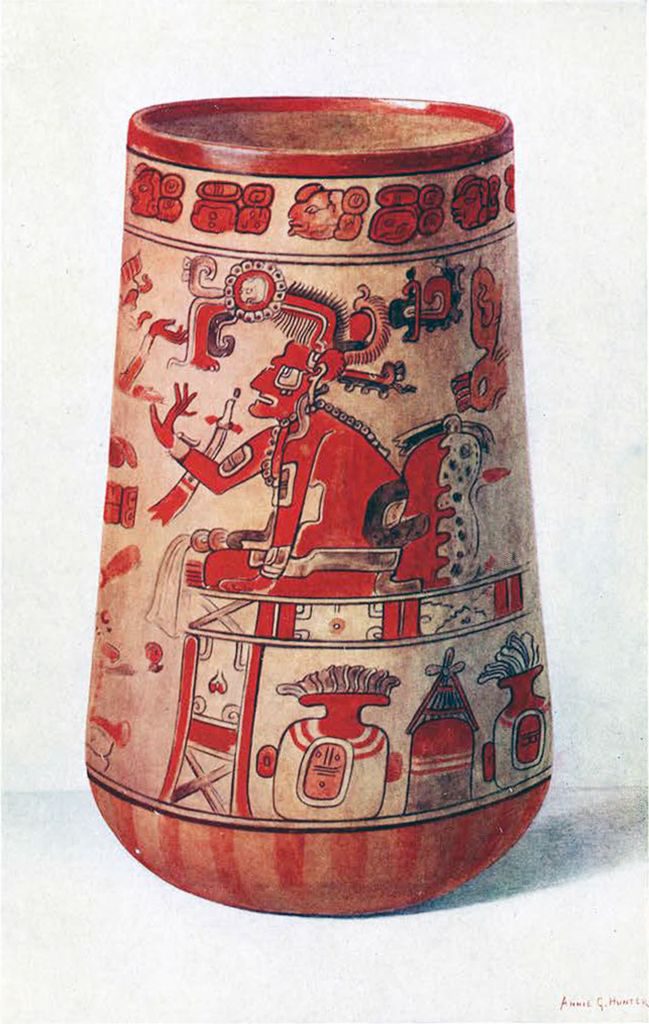
A group of vases, found chiefly in Guatemala and exhibiting characteristics that distinguish it sharply from other known groups, has for long been recognized from fugitive pieces here and there and also by examples derived from well-defined sources in the course of properly conducted excavations. A piece of this pottery, long deposited in the Museum of Bristol, England, is the one I have selected by way of illustrating the group. The drawing in water colour by Miss Annie Hunter is a faithful copy of the vase itself.
The pottery is made of a fine paste and is baked fairly hard, though not so hard as some other types of vase from the same region. The outer surface is covered with a yellow or cream colored slip with considerable body. To this slip has been imparted a high finish resembling a dull polish, I presume by rubbing with a smooth hard implement before baking. Upon this prepared surface the decorations are painted in red, black and white, and sometimes yellow. The subjects represented most frequently appear to be mythological. Human figures predominate and among the things seen are figures of other animals, symbols, altars, utensils, implements and paraphernalia, conventional designs and hieroglyphics. Classified according to shape, these vases fall into several categories; one of these categories is well illustrated by the example which now is for the first time published.
G. B. G.
NOTE.—The confusing of left and right in the drawing of hands and feet is not peculiar to Maya art. I recall a panel representing one of the saints, painted by a French artist of the 15th century. In this painting the saint’s feet are both right feet. I recall also a Chinese painting of an early period representing a saint both of whose feet are left feet.
Mr. Bishop informs me that he has seen in early Chinese and Japanese paintings, intentional imperfections and inaccuracies of drawing, introduced to avoid offending the gods.
Dr. Luce has called my attention to similar intentional inaccuracies introduced by Byzantine artists into their paintings from similar motives.
*1 See Memoirs of the Peabody Museum of Harvard University. Vol. 1.
*2 The circumstances hare specified apply also to the next three sculptures illustrated in this paper.

